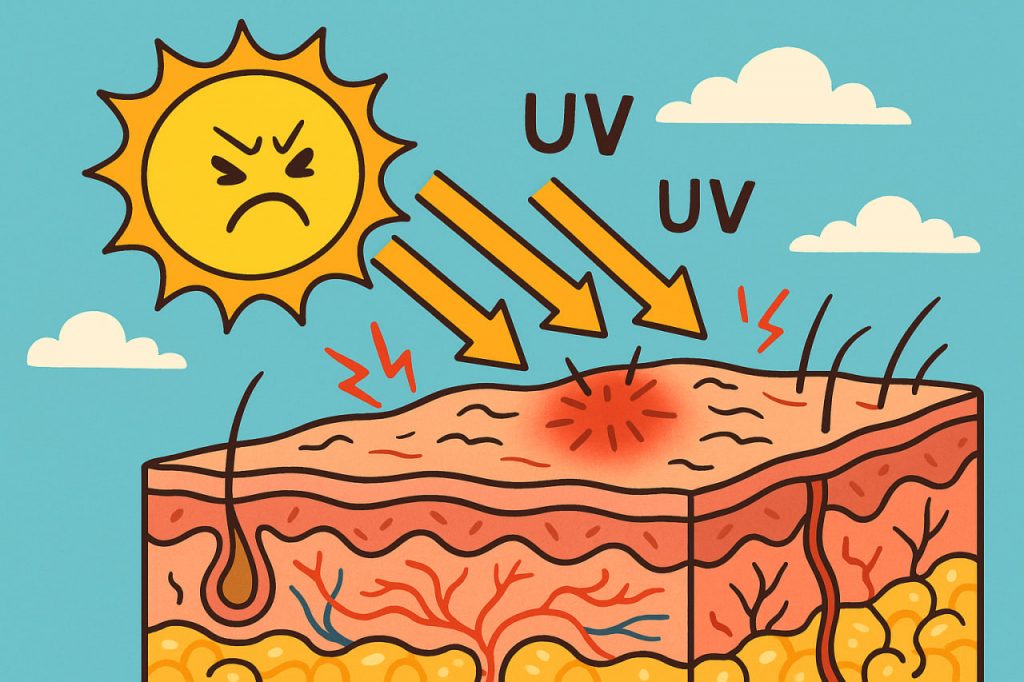Ultraviolet (UV) radiation from the sun is one of the most significant environmental factors that affect human skin. While moderate exposure to sunlight is necessary for vitamin D synthesis, excessive or unprotected UV exposure can cause acute and chronic damage to the skin. Understanding how UV rays interact with skin cells helps explain sunburn, skin aging, and the development of skin cancer.
Types of Ultraviolet Radiation
Sunlight contains three types of UV radiation: UVA, UVB, and UVC. UVC rays are absorbed by the ozone layer and do not reach Earth’s surface. UVB rays primarily affect the skin’s outer layer (the epidermis) and are responsible for sunburn. UVA rays penetrate deeper into the dermis and are associated with long-term damage such as photoaging.
Although UVA is less energetic than UVB, it makes up over 90% of UV radiation that reaches the skin. Both types can damage DNA in skin cells and generate reactive oxygen species (ROS), which accelerate cellular damage.
Short-Term Effects: Sunburn and Inflammation
One of the most immediate effects of UV exposure is sunburn, a form of acute inflammation caused by DNA damage in skin cells. In response, the body increases blood flow to the skin, causing redness, heat, and swelling. In more severe cases, the skin may blister and peel.
The immune system activates repair mechanisms, but excessive exposure can overwhelm these processes. Repeated sunburns, especially during childhood, significantly increase the risk of developing melanoma, the most dangerous form of skin cancer.
Long-Term Effects: Aging and Cancer
Chronic exposure to UV radiation accelerates skin aging, also known as photoaging. It breaks down collagen and elastin in the dermis, leading to wrinkles, pigmentation, rough texture, and loss of elasticity. UVA rays, in particular, penetrate deep into the skin and trigger long-term structural damage.
UV-induced mutations in DNA can lead to abnormal cell growth. Over time, this can result in basal cell carcinoma, squamous cell carcinoma, or melanoma. The cumulative effect of UV exposure throughout life is a major risk factor for developing these diseases.
Role of Melanin in Protection
The skin contains a pigment called melanin, which helps absorb and disperse UV radiation. People with darker skin tones have higher melanin levels and thus greater natural protection against UV damage. However, melanin does not block all UV rays, and damage can still occur.
Melanocytes, the cells that produce melanin, can become damaged under repeated UV stress. This may lead to uneven pigmentation or even trigger the formation of moles and precancerous lesions.
Artificial Sources of UV and Skin Exposure
In addition to sunlight, tanning beds, UV lamps, and some industrial equipment emit ultraviolet radiation. Artificial sources often deliver intense, concentrated UV doses that can be more harmful than natural sunlight.
Frequent use of tanning beds has been directly linked to increased skin cancer rates, especially among young adults. Unlike sunlight, which varies by season and time of day, artificial UV is often used without proper timing, increasing cumulative skin damage.
Conclusion
Ultraviolet radiation has a profound impact on skin health. While it plays a role in natural processes like vitamin D production, excessive or prolonged exposure can damage skin cells, accelerate aging, and increase cancer risk. Understanding the mechanisms of UV interaction with the skin is crucial for developing protective strategies, guiding public health policy, and minimizing harmful effects.
Glossary
- Ultraviolet (UV) radiation — a type of electromagnetic radiation emitted by the sun, categorized as UVA, UVB, or UVC.
- Epidermis — the outermost layer of the skin.
- Dermis — the deeper layer of skin beneath the epidermis.
- DNA — deoxyribonucleic acid, the molecule that carries genetic instructions.
- Reactive oxygen species (ROS) — unstable molecules that damage cells and DNA.
- Photoaging — premature aging of the skin caused by prolonged UV exposure.
- Melanin — a natural pigment in the skin that absorbs UV radiation.
- Skin cancer — a disease in which abnormal skin cells grow uncontrollably, often due to UV damage.


